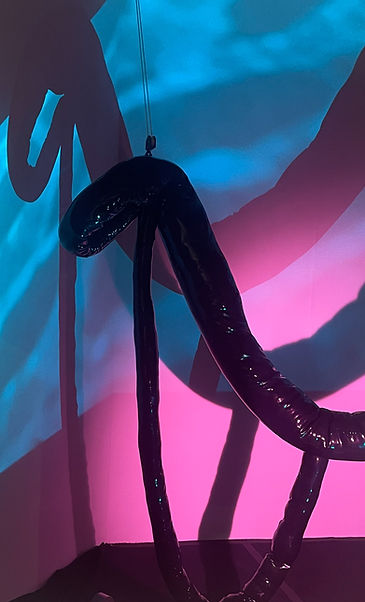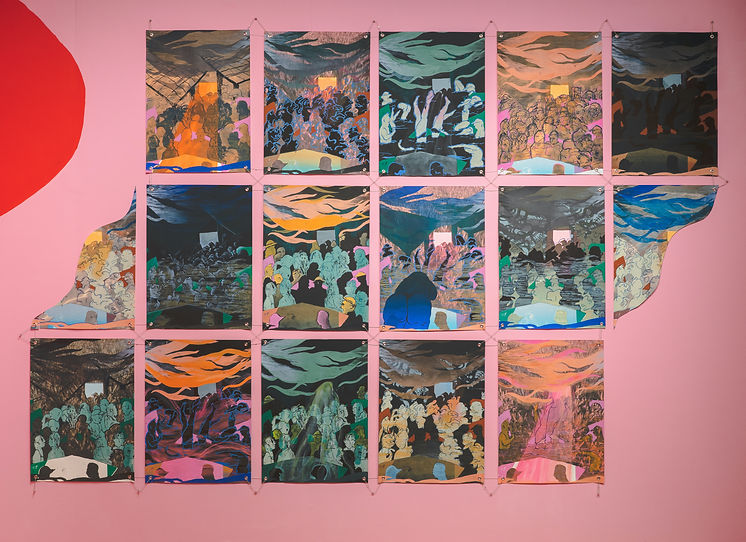Other Structures : San Francisco State University MFA Thesis Exhibition 2023
three holes, two feet, one guy
velvet with screenprint burnout, satin with screenprint burnout, dye, string of beads, thread, wood, drywall, paint, vinyl
2023
lure
installation of latex sourced from Mr. S Leather's deadstock from when they used to make latex, rubber cement, rope, lighting gels, vivishine; projection of sunlight reflecting from the pools of The Golden Gate Angling & Casting Club; and pillow stuffing, stage lighting, pulley system, duvateen sourced from Luster Production's studio (inherited from the old Armory building when it was owed by Kink.com)
2023
sea of fags
gouache, screenprint, inkjet on cotton paper, black cotton paper, grommets, ballchain
2022












Essay by Dionne Lee
Link to Show Catalogue HERE
Visibility is not linear, it is peripheral and connective. To truly see and be seen, one must experience a level of registration within the body. Leonard Reidelbach explores the intricacies of visibility within identity and personhood through textiles, printmak- ing, and installation. With connection to community as an anchor, Reidelbach looks at how the dance between body and space is negotiated, or liberated, in public and private.
Sea of Fags is a gridded installation of screenprints depicting scenes of collective move- ment and pleasure. Underneath spotlights, bodies float, dip, and do headstands among waves. The figures are both within the sea and the sea itself. Sea of Fags is a study of endless expansion, when the individual self merges with the communal body, and what waves liberation can crest.
In the cheekily titled, Three holes, two feet, one guy, a free-falling, or perhaps freely falling, figure takes up a wall. One could imagine the figure is a scaled-up version of a body swimming among Sea of Fags. The holes carved out of the body function as veiled portals, as they are partly obscured by velvet treated with a devoré effect. These open- ings are both invitation and boundary. We are generously offered the lushness of velvet as a threshold into a space to visually roam, but not enter; a soft permission to look with limitation. This negotiation is the artist’s assertion of a right to opacity as a way to uphold and protect pleasure. Reidelbach is inspired by the potential of the body, em- ploying a trans-lens to explore the boundless and soft-edged nature of self. This makes the right to opacity – the right to not be seen, to not be registered—an act of self-de- fense. Bringing to question how privacy, as a means of safety, can be obtained for the trans body. To accept the complications of visibility is to understand the consequences of looking without registration. Yet, Reidelbach takes advantage of this complication as an opportunity; the sheerness of the holes, where the pile of the velvet has been burned away, is rose-tinted.
Looking through Three holes, two feet, one guy takes us to another ocean, an inner landscape of water reflecting off of surfaces. This protected space reads as a room for becoming, the boundless and cyclical process of unfolding like a wave–cresting and crashing back into the larger ocean body.